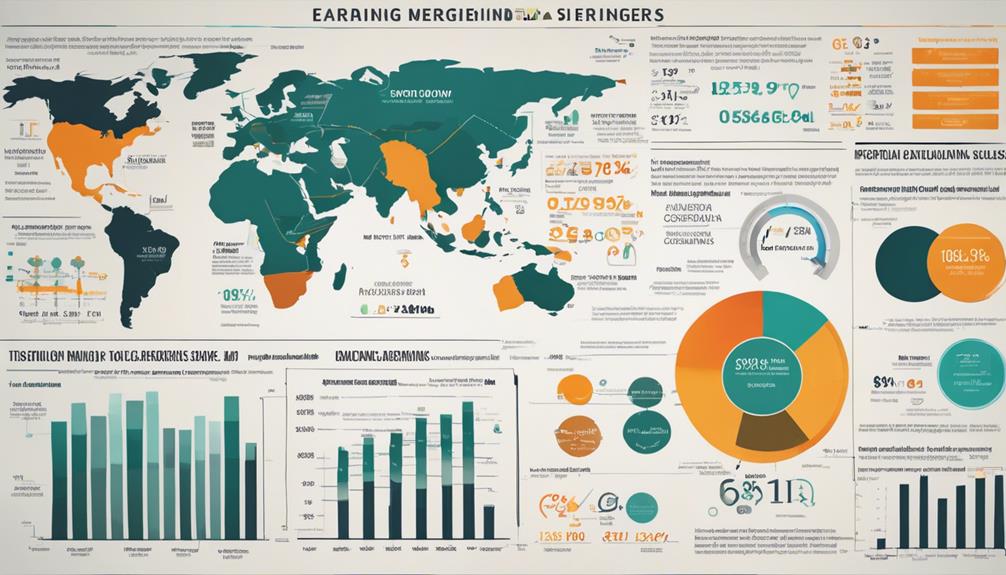Accounting Implications of Stock Mergers

Mergers and acquisitions come in various forms, with stock mergers being a common method for companies to combine their operations. In a stock merger, the acquiring company purchases the target company's shares using its own stock. This type of merger can have significant accounting implications that need to be carefully evaluated to ensure accurate financial reporting.
Determining the fair value of the assets acquired in a stock merger is crucial for the accounting process. The acquiring company must assess the value of tangible assets, such as equipment and property, as well as intangible assets like intellectual property or brand value. This valuation process impacts the financial statements of the combined entity and influences decisions regarding the recognition of goodwill.
Accounting standards, such as ASC 805, provide guidelines for how companies should account for stock mergers. These standards ensure that the financial reporting is transparent and consistent, allowing stakeholders to understand the impact of the merger on the company's financial position and performance.
Stock mergers also have implications for the equity structure of the merged entity and can affect calculations such as earnings per share. Understanding these effects is essential for investors and analysts who rely on accurate financial information to make informed decisions about the company's future prospects.
In conclusion, stock mergers require careful consideration of the fair value of acquired assets, adherence to accounting standards, and an understanding of their impact on financial reporting. By following best practices and seeking professional guidance, companies can navigate the complexities of stock mergers and create a solid financial foundation for the combined entity.
Key Takeaways
- Independent appraisers play a crucial role in stock mergers by assessing the fair value of assets and liabilities. This assessment ensures that the valuation is accurate and reflects the true worth of the entities involved in the merger.
- Identifying and valuing intangible assets is essential for recognizing goodwill in stock mergers. Goodwill represents the excess of the purchase price over the net assets acquired and requires careful evaluation to determine its impact on the financial statements.
- Stock mergers can have significant implications on ownership structure and earnings per share. It is important for companies to provide transparent reporting and disclosure of the financial effects of the merger to keep stakeholders informed.
- Financial reports should include detailed disclosures and pro forma information to provide a comprehensive understanding of the financial performance of the merged entity. This transparency is essential for investors and analysts to make informed decisions.
- Proper allocation of the purchase price, consolidation of financial statements, and adherence to accounting standards such as ASC 805 are essential for consistent and transparent reporting in stock mergers. Following these guidelines ensures that the financial information accurately reflects the impact of the merger on the combined entity.
Evaluating Fair Value of Acquired Assets
When assessing the fair value of acquired assets in stock mergers, it's crucial to determine the market worth of both tangible and intangible assets. This process involves evaluating the condition, utility, and remaining useful life of the acquired assets. Professional appraisers may be involved to provide independent valuations, ensuring an accurate assessment.
Determining the fair value of acquired assets is essential for proper accounting treatment and reporting. The key value considerations directly impact the distribution of the purchase price to specific assets, which is critical for financial reporting.
An accurate evaluation of fair value enables us to reflect the true economic value of the acquired assets on the balance sheet, offering stakeholders transparent and reliable financial information.
Determining Appropriate Accounting Method
We choose to utilize the carryover basis method for stock mergers as the most appropriate accounting approach. This method involves recording the acquired company's assets and liabilities at their historical values without immediate recognition of gains or losses on the balance sheet. Goodwill is recognized as the excess of the consideration transferred over the fair value of identifiable net assets. This method ensures a seamless transition during the acquisition process and maintains the integrity of the acquired company's financial information. By keeping assets and liabilities at their original carrying values, we provide a clear and consistent representation of the merged entity's financial position, enabling stakeholders to make well-informed decisions. This approach aligns with the principles of transparency and accountability, essential for fostering trust in financial reporting.
The carryover basis method has been widely accepted and utilized in the accounting industry for stock mergers. It offers a practical and efficient way to handle the complexities of merging entities, ensuring that financial statements accurately reflect the combined entity's financial position. This method has proven to be reliable and effective in maintaining the continuity of financial reporting while upholding the highest standards of financial stewardship.
Recognizing Goodwill and Intangible Assets

In stock mergers, it's crucial to accurately identify and value goodwill and intangible assets to truly capture the value of the deal.
Goodwill comes into play when the buying price surpasses the fair value of identifiable net assets, while intangible assets such as customer relationships and patents are accounted for separately.
To determine the fair values of these components correctly, expertise in specialized valuation is necessary.
Recognizing and valuing these aspects accurately is key to presenting a precise financial snapshot of the merger.
Identifying Goodwill Valuation Criteria
Understanding the valuation of goodwill in stock mergers involves analyzing the excess of the purchase price over the fair value of identifiable net assets acquired. This includes intangible assets like brand recognition, customer relationships, and patents, which contribute to the calculation of goodwill.
By accurately determining the fair value of these intangible assets, we can identify the amount of goodwill generated from the merger. Goodwill isn't amortized but is subject to impairment testing at least annually.
Having a clear grasp of these valuation criteria allows for effective decision-making in stock mergers. It's essential to consider the impact of goodwill on financial reporting and strategic planning for the merged entity.
Our expertise in this area enables us to offer tailored solutions to our clients, ensuring that the accounting implications of stock mergers are appropriately managed. By guiding our clients through the complexities of goodwill valuation, we help them navigate stock mergers with confidence and achieve their desired outcomes.
Recognizing Intangible Asset Impairment
Recognizing the impairment of acquired intangible assets, including goodwill, is a crucial step in the accounting process post a stock merger. When the carrying value of these assets surpasses their fair value, an impairment charge must be recorded to ensure the balance sheet reflects the assets' true value.
Intangible assets such as trademarks and customer relationships necessitate annual impairment testing to validate their carrying values. This involves comparing the asset's book value with its estimated fair value. If the fair value is lower, a non-cash charge is recorded in the income statement, adjusting the asset's value accordingly.
Goodwill, which represents the excess paid over identifiable net assets in an acquisition, also requires impairment testing. Through analyzing market conditions and financial performance, we can assess whether the original goodwill valuation is still appropriate. Neglecting to acknowledge impairment can result in inflated assets and unreliable financial reporting.
Thorough intangible asset impairment testing ensures that our balance sheet accurately mirrors the genuine economic essence of a merger, fostering transparency and informed decision-making.
Accounting for Acquired Intangibles
When engaging in a stock merger, it's crucial to account meticulously for the acquired intangible assets and the resulting goodwill, as these components have a significant impact on the post-merger financial statements. Intangible assets obtained in a stock merger, such as brand names or patents, are identified separately from goodwill and assessed at their fair market value. This practice ensures accurate portrayal of the organization's assets and liabilities in the consolidated financial statements.
Goodwill is determined as the surplus of the purchase price over the fair value of the net identifiable assets acquired. Precisely managing this goodwill is essential, as it directly influences the balance sheet and future financial performance of the acquiring entity. Adhering to these guidelines allows us to offer stakeholders a clear and dependable view of the merged entity's financial well-being.
This diligent approach in accounting for acquired intangibles showcases our dedication to innovation and robust financial strategies, fostering trust and confidence in our organization.
Impacting Equity Structure
A stock merger can have a significant impact on the equity structure of the acquiring company, potentially diluting the ownership interests of existing shareholders. When a company acquires another through a stock merger, it often issues new shares to the target company's shareholders, leading to a substantial change in the ownership percentages within the combined entity.
Ownership percentages and voting rights can be affected by a stock merger, resulting in dilution for existing shareholders and shifts in voting power. The increased number of shares outstanding can also concentrate voting influence among certain shareholders, altering ownership interests and transforming voting dynamics within the company.
Understanding these implications is crucial for financial reporting and shareholder communication post-merger. The equity structure post-merger reflects the combined ownership interests of both the acquiring and target companies' shareholders, and managing this change is essential for maintaining transparency and stakeholder trust.
Affecting Earnings Per Share Calculations

Stock mergers can have a significant impact on earnings per share (EPS) calculations for the combined entity. The weighted average number of shares outstanding, a crucial factor in EPS, can be altered by mergers through the issuance of new shares or the conversion of securities.
Understanding the effects of stock mergers on EPS is important. Additional shares or convertible securities can dilute EPS, reducing the overall value. Adjustments to both the numerator (net income) and denominator (shares outstanding) of the EPS formula are necessary to accurately reflect the financial position post-merger.
Accurate EPS calculations are essential for proper financial reporting and analysis in mergers and acquisitions. It's crucial to comprehend the tax implications and financial statement impacts of these changes.
Seeking specialized expertise can help navigate the complexities of EPS calculations during a merger effectively.
Detailed Disclosures in Financial Reports
Let's delve into the detailed disclosures required in financial reports for stock mergers, which include providing pro forma financial information to reflect the combined entity's position. This supplemental data serves to help stakeholders grasp the merger's impact on the financial statements more effectively. These disclosures play a vital role in offering a comprehensive view of the combined organization's financial performance.
Stock mergers can take various forms, such as horizontal mergers where companies in the same industry combine, or vertical mergers where companies in different stages of the supply chain merge. Each type of merger brings different implications for the financial health and future prospects of the combined entity.
The transparency provided through detailed disclosures in financial reports for stock mergers is crucial for investors, analysts, and other stakeholders to make well-informed decisions. By presenting a clear picture of the financial impact of the merger, these disclosures enhance trust and confidence in the newly formed entity's operations and outlook.
Merger-Related Disclosures Required
Merger-related disclosures in financial reports provide stakeholders with a comprehensive understanding of the combined entity's financial position, including crucial details on revenue, changes in net assets, and performance indicators. These disclosures offer a detailed insight into the impact of the merger, presenting pro forma financial information that illustrates the hypothetical combined financials as if the merger had taken place earlier.
Stakeholders benefit from these disclosures by gaining valuable insights into the assets, liabilities assumed, and expected financial performance of the combined organization. Adhering to disclosure requirements ensures transparency and clarity in financial reporting, empowering stakeholders to make well-informed decisions.
Essential disclosures in merger-related financial reports encompass pro forma financial information, changes in net assets without donor restrictions, performance indicators, revenue projections, and the anticipated impact on the combined entity's financial position. These disclosures collectively provide a comprehensive overview of the merged entity's financial health and prospects.
Accounting Treatment Considerations
When disclosing the accounting treatment for stock mergers in financial reports, it's crucial to provide a comprehensive breakdown of the fair value of acquired assets, assumed liabilities, and any contingent consideration. This transparency allows investors to grasp the underlying value drivers of the merger. The purchase price allocation should be clearly outlined, showing how it was divided among identifiable assets, intangible assets, and goodwill.
In addition, the disclosure should include the valuation techniques and significant assumptions used to determine these fair values. This may involve utilizing income, market, or cost approaches, along with key inputs such as discount rates, growth projections, and market comparables. It's essential to align the accounting policies of the merging entities and thoroughly document any adjustments made.
Pro forma financial statements reflecting the combined entity's financial position can provide valuable insights into the expected impact of the merger. By addressing these accounting treatment considerations with transparency and detail, trust and confidence in the merger process can be fostered.
Transparency in Reporting
In financial reports, it's crucial to provide clear and detailed information on stock mergers to ensure transparency and build trust among stakeholders. Transparency in reporting includes disclosing key details such as the nature of the transaction and the fair value of consideration exchanged. Additionally, it's essential to outline the allocation of the purchase price, any contingent consideration arrangements, and the impact of these on accounting policies and financial metrics.
Stakeholders also need to be informed about the significant assumptions made in determining fair values and the reasoning behind the purchase price allocation. Understanding how these factors affect goodwill is important for a comprehensive understanding of the financial implications of stock mergers.
Assessing Financial Position and Performance

When assessing a stock merger, it's crucial to examine the combined balance sheet to accurately report the financial position post-merger. Analyzing the assets and liabilities of the merged entities helps us gauge the true strength of the newly formed organization. This comprehensive review enables us to pinpoint any synergies or redundancies that could impact the overall financial health of the entity.
Equally important is the comparison of the income statements before and after the merger. Evaluating changes in revenue, expenses, and net income provides valuable insights into the financial performance impact of the merger. Thorough analysis of these statements can reveal potential tax implications, such as the utilization of net operating losses or alterations in income tax provisions.
Assessing the effects of the stock merger on cash flows is vital for evaluating liquidity and operational activities. Understanding the shifts in operating, investing, and financing cash flows assists in determining the ability of the combined entity to generate and utilize cash efficiently. This evaluation plays a critical role in maintaining a robust financial position and supporting future growth initiatives.
Accounting Treatment for Combined Entity
In a stock merger, the financial statements of the two entities are combined as if they've always operated as a single organization. This method helps maintain the historical cost basis of the assets and liabilities acquired, without requiring any fair value adjustments. Consequently, any gains or losses aren't immediately recognized on the balance sheet of the acquiring company.
The accounting treatment for a combined entity in a stock merger involves recording the acquired company's assets and liabilities at their historical carrying amounts, rather than at fair value. The issuance of stock and any related additional paid-in capital are reflected in the equity section.
Merger's Impact on Financial Statements

Stock mergers can have a profound impact on a company's financial statements, affecting the balance sheet, income statement, and statement of cash flows. When companies merge, they must combine the assets, liabilities, and equity of the merging entities onto the balance sheet, reflecting the new ownership structure and financial position.
The income statement is also affected by stock mergers, as the combined revenues, expenses, and profits of the merging companies are now reported together. This can lead to significant changes in both the top and bottom lines, which investors and analysts will closely analyze.
Furthermore, the statement of cash flows undergoes adjustments as the cash flows from operating, investing, and financing activities are merged. This integration of financial activities is crucial for shareholders' equity, as it establishes the new ownership interests in the merged company.
Understanding these financial statement changes is essential for grasping the true impact of a stock merger. Accurate accounting and reporting are vital to provide transparency and ensure a seamless integration process.
Proper Accounting Ensures Accurate Reporting
Properly accounting for a stock merger is essential to accurately report its impact on financial statements. When it comes to mergers and acquisitions (M&A), recording the fair value of the acquired company's stock as consideration is crucial. This fair value is then added to the acquirer's balance sheet as an increase in common stock and additional paid-in capital.
Accounting plays a pivotal role in ensuring compliance with accounting standards and regulatory requirements. It also provides stakeholders, such as investors and creditors, with trustworthy and transparent financial information.
Implications for Consolidated Financial Statements

In a stock merger, the balance sheets and income statements of both the acquiring and acquired companies are consolidated. This process combines the financial information of the two entities to present a unified picture of the new, merged organization. By consolidating the financial statements, we can analyze the overall financial position and performance of the combined entity post-merger.
Consolidated financial statements provide a comprehensive view of the organization by aggregating the assets, liabilities, revenues, and expenses of the acquiring and acquired companies. This approach allows investors, analysts, and other stakeholders to assess the financial health and performance of the new entity as a whole, rather than viewing the companies separately.
Through consolidated reporting, we can identify any potential synergies, cost savings, or challenges that may arise from the merger. This holistic view enables management to make informed decisions about future strategies, investments, and operational changes to maximize the benefits of the merger and drive long-term growth and profitability.
Consolidated Balance Sheet
Consolidating balance sheets is a critical process in accounting for stock mergers. It enables us to showcase the combined financial position of the newly merged entity by aggregating the assets, liabilities, and equity of the merging companies. This provides a comprehensive overview of the organization's financial health.
In stock mergers, the equity section of the consolidated balance sheet holds particular importance. This is due to the issuance of new stock to acquire the target company, which directly impacts the equity portion. During consolidation, adjustments are made to ensure alignment of accounting policies and to eliminate any intercompany transactions. These steps are essential for accurately portraying the financial status of the combined entity.
The consolidated balance sheet offers a detailed snapshot of the merged organization's financial standing, presenting a unified view of assets, liabilities, and equity. Through stock mergers, a single, cohesive balance sheet is created for the newly formed entity, reflecting the culmination of the merger process.
Consolidated Income Statement
The consolidated balance sheet gives a snapshot of the combined financial position after a stock merger, while the consolidated income statement reveals how well the merged entity is performing.
In a stock merger, we bring together the financial results of both the acquiring and acquired companies, showing their combined revenues, expenses, and net income. This gives us a clear picture of the financial synergy and overall performance of the newly merged business.
When preparing the consolidated income statement, we make necessary adjustments to ensure consistent accounting policies and remove any intercompany transactions. Analyzing this statement helps us understand the efficiency and profitability of the merged operation.
This data is crucial for evaluating the success of the stock merger and making informed decisions for the future.
Accounting Considerations for Stock Transactions
When examining the accounting implications of stock mergers, several important factors come to light. The fair value of the shares exchanged is the key element used to record the acquisition, which directly influences the valuation of the target company. This valuation impacts the equity section of the balance sheet for both the acquiring company and the target company, reflecting the change in ownership that occurs as a result of the merger.
Accounting for stock mergers follows the guidelines outlined in ASC 805, ensuring that reporting is consistent and transparent. Mergers and acquisitions involving stock transactions require a thorough analysis of the fair value of the shares being exchanged, which is a critical step in the overall accounting process.
It's essential to differentiate the accounting treatment for stock mergers from that of cash-based transactions, highlighting the significance of accurately valuing the equity instruments involved in the exchange.
Navigating Accounting Complexities of Mergers

When delving into the accounting complexities of mergers, one crucial aspect to consider is the valuation of assets involved. This process involves assessing the fair market value of all assets, including tangible assets like property and equipment, as well as intangible assets such as patents or trademarks. Properly valuing these assets is essential for accurately representing the financial health of the combined entity post-merger.
Goodwill, another key consideration in mergers, represents the excess of the purchase price over the fair market value of identifiable assets acquired. It reflects the intangible value of factors like brand reputation, customer relationships, and strategic advantages. Understanding the implications of goodwill on the financial position of the merged company is vital for stakeholders to gauge the true value created by the merger.
In the realm of tax considerations, mergers can have significant implications on the tax liabilities of the involved entities. Factors such as the structure of the merger, the jurisdictions involved, and any potential tax incentives or consequences must be carefully analyzed to optimize tax efficiency and compliance. By addressing these tax considerations proactively, companies can mitigate potential risks and maximize the benefits of the merger process.
Identifying Asset Valuation Challenges
Valuing assets in stock mergers can be quite challenging, especially when it comes to determining the fair values of intangible assets, goodwill, and contingent liabilities. The process involves assessing and accurately valuing assets like customer relationships, technology, and other intangible assets, which can be complex.
Additionally, evaluating contingent liabilities, such as pending lawsuits or warranty claims, adds another layer of complexity to the valuation process in mergers and acquisitions.
To tackle these challenges effectively, it's essential to leverage expertise in valuation methodologies to ensure the fair value assessment of acquired intangible assets is accurate. Thorough analyses of contingent liabilities should be conducted to make appropriate provisions and allocate the purchase price carefully to reflect the true value of the acquired assets and liabilities.
Staying informed about the latest accounting standards and best practices for asset acquisitions is crucial in navigating asset valuation complexities in M&A transactions.
Collaboration with cross-functional teams is key to ensuring a comprehensive and well-informed approach to asset valuation in stock mergers. By working together and utilizing the right expertise and methodologies, companies can overcome these valuation challenges and make sound decisions during mergers and acquisitions.
Accounting for Goodwill Implications
Accounting for goodwill in stock mergers involves navigating a complex set of rules and practices to ensure accurate financial reporting. The key is to allocate the purchase price to identifiable assets and liabilities, recognizing goodwill as the excess of the purchase price over the fair value of these net assets. Goodwill isn't subject to amortization but is instead evaluated annually for potential impairment, comparing its carrying amount to its fair value.
This process is crucial for companies engaged in mergers and acquisitions. By correctly accounting for goodwill, organizations can achieve transparent financial reporting and adhere to industry standards. Understanding the nuances of goodwill valuation and impairment testing is essential.
Navigating Tax Considerations
Understanding the tax implications of stock mergers is crucial for maximizing the benefits of these complex transactions. When corporations undergo stock mergers, they may qualify for tax-free treatment under IRC Section 368. This provision allows for a smooth transfer of assets and liabilities without triggering immediate tax consequences. For acquiring corporations, this tax-free treatment means they can avoid recognizing any gain or loss on the stock exchanges, preserving the tax advantages of the merger.
It is important to carefully assess the tax basis implications of a stock merger. The acquiring corporation inherits the acquired corporation's asset basis, which can have a significant impact on the combined entity's long-term tax planning and ability to optimize tax benefits.
To navigate these complexities effectively, it's advisable to utilize the expertise and resources provided by Bloomberg Tax solutions. Their valuable insights and tools can help you make well-informed decisions and ensure that your stock merger transactions are structured in a tax-efficient manner.
Reporting Requirements for Stock Acquisitions
When dealing with stock acquisitions, it's crucial to disclose the fair value of consideration exchanged, such as shares, options, and other securities. This transparency is key to meeting accounting standards and regulatory requirements.
As part of the acquisition disclosure process, detailed information about the acquired entity's assets, liabilities, and equity must be provided. Accurately determining the purchase price allocation is essential, as it involves reporting the fair value of identifiable assets acquired and liabilities assumed.
Additionally, any contingent consideration, including fair value measurements and potential adjustments based on future performance, must be accounted for. This level of detail is vital in M&A transactions, enabling stakeholders to grasp the intricacies of the deal and its financial impact.
Frequently Asked Questions
How Do You Account for a Merger in Accounting?
When a stock merger occurs, we account for it by recognizing fair value adjustments, conducting asset impairment testing, and identifying contingent liabilities. This ensures that the financial statements of the merged entity accurately represent the economic reality of the combined organization.
Stock mergers are a type of merger where the acquiring company purchases the target company's stock with its own stock. This can result in a significant change in the financial structure of both companies, impacting their balance sheets and income statements.
By recognizing fair value adjustments, we are able to account for the difference between the market value of the target company's stock and the price paid by the acquiring company. This adjustment helps in reflecting the true value of the combined entity's assets and liabilities.
Asset impairment testing is crucial in a stock merger to assess the value of the acquired company's assets and determine if any impairment losses need to be recorded. This ensures that the financial statements provide an accurate representation of the merged entity's financial position.
Identifying contingent liabilities is also important in accounting for a stock merger. These are potential obligations that may arise in the future, such as legal claims or warranty obligations. By identifying and disclosing these liabilities, we can provide a complete picture of the financial risks associated with the merger.
What Are the Implications of Merger?
Understanding the implications of mergers goes beyond simply adjusting fair values. Consolidated financial reporting and acquisition accounting allow us to explore the potential of strategic combinations, uncovering fresh opportunities for growth and value creation.
In the realm of stock mergers, companies can join forces to pool their resources and expertise, leading to increased market share and competitiveness. This type of merger often results in a stronger, more resilient entity that is better equipped to navigate challenges and capitalize on market trends.
Stock mergers can also provide companies with access to new technologies, distribution channels, and customer bases. By combining forces, organizations can streamline operations, reduce costs, and enhance their overall efficiency.
Moreover, stock mergers can create synergies that drive innovation and fuel long-term success. When two companies with complementary strengths come together, they can leverage their combined expertise to develop breakthrough products and services that meet evolving customer needs.
Ultimately, stock mergers have the potential to reshape industries, drive economic growth, and unlock value for shareholders. By strategically evaluating opportunities for mergers and acquisitions, companies can position themselves for sustained success in an ever-evolving business landscape.
Are Stock for Stock Mergers Taxable?
Stock for stock mergers are typically non-taxable events, providing companies with a tax-efficient way to merge and consolidate their operations. By exchanging shares of stock in one company for shares of stock in another, companies can combine their resources and strengths without incurring immediate tax liabilities for shareholders. This method allows for a seamless transition and restructuring of balance sheets without the burden of significant tax considerations.
Stock for stock mergers offer a flexible and innovative approach to corporate consolidation, enabling businesses to streamline operations and enhance their competitive position in the market. This type of merger can result in synergies and cost savings, as companies can leverage their combined resources to drive growth and efficiency. Additionally, by deferring tax obligations through a stock-based transaction, companies can focus on integrating their operations and maximizing shareholder value without the pressure of immediate tax consequences.
What Happens to a Stock When Companies Merge?
When companies merge, shareholders tend to react positively to the merger announcement. This is often reflected in an improvement in the pre-merger stock performance. The value of the merged entity's stock is then determined by the agreed-upon exchange ratio.
There are several types of mergers and acquisitions that companies can engage in. These include horizontal mergers, where companies in the same industry merge, vertical mergers, where companies in different stages of the supply chain merge, and conglomerate mergers, where companies in unrelated industries merge. Each type of merger can have different implications for the stock performance of the merged entity.
In the case of a stock merger, the performance of the merged entity's stock can be influenced by a variety of factors, including market conditions, industry trends, and the strategic rationale behind the merger. It is important for shareholders to carefully evaluate these factors and consider the long-term implications of the merger on the stock performance.
Conclusion
Stock mergers come in different forms, each with its unique accounting implications that can significantly impact a company's financial standing. Understanding the nuances of these mergers is crucial for organizations looking to navigate the complex terrain of financial reporting post-merger.
One key statistic worth noting is that more than 70% of mergers and acquisitions fail to achieve their intended goals. This failure is often attributed to a lack of consideration for critical accounting factors such as fair value assessments, goodwill recognition, and consolidated reporting. Mastery of these accounting principles is essential for ensuring a smooth merger process and maintaining financial integrity after the transaction is completed.
In the realm of stock mergers, organizations must carefully evaluate the fair value of assets and liabilities to accurately reflect the true financial position post-merger. Goodwill recognition also plays a vital role in determining the value of the acquired company and its potential impact on the overall financial statements.
Additionally, consolidated reporting must be diligently executed to provide a comprehensive view of the combined entity's financial performance.
By paying close attention to these accounting factors and understanding the implications of stock mergers, organizations can increase their chances of a successful merger and avoid the pitfalls that often lead to failed acquisitions. A solid grasp of fair value assessments, goodwill recognition, and consolidated reporting is key to achieving financial success in the aftermath of a stock merger.





